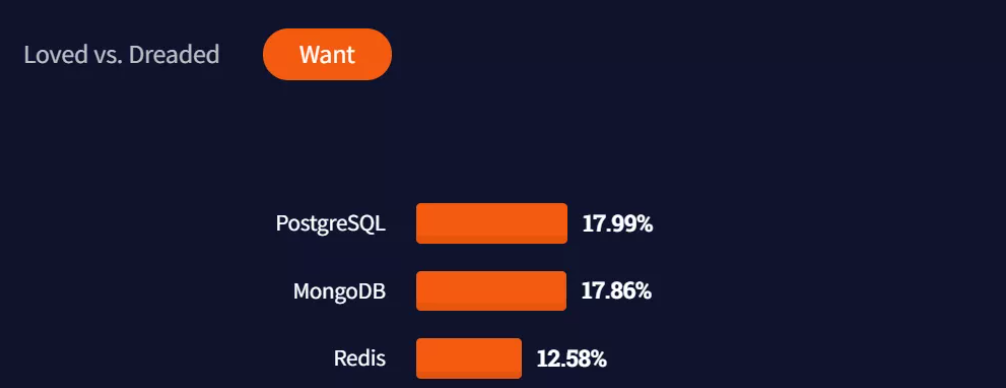By Xie Guiqi
According to the Stack Overflow 2021 research report for developers, 72,517 developers worldwide participated in the research. PostgreSQL was selected as the most wanted database management system by global developers, which shows how much developers love it.

Source: https://insights.stackoverflow.com/survey/2021#most-loved-dreaded-and-wanted-database-want
PostgreSQL has been popular worldwide for a long time because of its reliability and robustness. In the DB-Engines ranking, PostgreSQL is the first (and only) database to win the DBMS of the Year award for three times. The global development team of PostgreSQL announced the official release of PostgreSQL 14 on September 30 in 2021 after many expectations from users. As the leader in the cloud market, Alibaba Cloud is also conducting R&D and tuning based on PostgreSQL 14 in the first place. Now, users can use PostgreSQL 14 services on Alibaba Cloud.
If you are using ApsaraDB RDS for PostgreSQL 9.4/10/11/12/13, you can easily upgrade to ApsaraDB RDS for PostgreSQL 14 on the console through the Version Update function. You do not need to update the version step by step following the operation guidelines.
ApsaraDB RDS for PostgreSQL is fully compatible with open-source PostgreSQL, bringing the new features of PostgreSQL 14 to you:
In terms of the application performance for businesses, PostgreSQL 14 has been optimized and improved significantly.
In terms of security, PostgreSQL 14 has two highlights:
PostgreSQL has always had extensive support for data types that the rich extensions allows PostgreSQL to specialize in processing data types, and PostgreSQL 14 continues to optimize on top of that.
PostgreSQL 14 has made great efforts to improve the work efficiency and user experience of DBA.
Logical replication API is enhanced to support streaming large in-progress transactions. Logical replication supports logical decoding and sending without waiting for transaction completion, which reduces the replication latency of large and long transactions. This is suitable for scenarios, such as multi-IDC deployment and architectures with many subscribers. And it supports multi thread, allowing you to receive WAL logical logs while synchronizing full data. This can shorten the time consumed for the first synchronization of large tables to become consistent. Besides, the ALTER SUBSCRIPTION syntax is enhanced, publications can easily be added or removed from a subscription, which makes subscription more convenient to manage.
The section above introduces some important features of open-source PostgreSQL 14. In addition, Alibaba Cloud ApsaraDB RDS for PostgreSQL 14 also has following exclusive capabilities of earlier versions.
The Ganos plugins (a spatio-temporal information engine) are supported to store, index, query, analyze, and compute spatial and spatio-temporal data efficiently. Ganos has been refined by different GIS scenarios and is simple and efficient to use. It is one of the best practices in the geographic information system (GIS) field.
The plugins of fully encrypted databases are supported. After a fully encrypted database is used, data is encrypted on the user side and passed to cloud databases. All data stored in the database, transmitted in the network, and cached in the memory are encrypted. No one except the data owner can access the plaintext data of the user to prevent end-to-end data leakage throughout the procedure. Fully encrypted databases are very suitable for privacy encryption scenarios like sensitive data in the finance, healthcare, government affairs, and marketing fields.
By default, the replication slots created on the primary instance by PostgreSQL are not synchronized to the secondary instance via the streaming replication protocol. Once failover, the logical replication slots are lost, and consequently, the logical subscriptions are interrupted. The Logical Replication Slot Failover feature can synchronize all logical replication slots from the primary RDS instance to the secondary RDS instance.
Like always, it brings a lot of exciting changes, that’s why PostgreSQL users seem to be eager for new versions. The good news is that Alibaba Cloud ApsaraDB RDS for PostgreSQL 14 is available now. You can click this link to upgrade to the latest version or start a free trial!
Six Technical Directions of Next-Generation Enterprise Databases
digoal - June 26, 2019
Alibaba Clouder - January 2, 2019
Alibaba Clouder - July 6, 2018
digoal - August 20, 2021
CloudSecurity - December 8, 2025
digoal - January 18, 2021
 PolarDB for PostgreSQL
PolarDB for PostgreSQL
Alibaba Cloud PolarDB for PostgreSQL is an in-house relational database service 100% compatible with PostgreSQL and highly compatible with the Oracle syntax.
Learn More Security Center
Security Center
A unified security management system that identifies, analyzes, and notifies you of security threats in real time
Learn More Database Security Solutions
Database Security Solutions
Protect, backup, and restore your data assets on the cloud with Alibaba Cloud database services.
Learn More AnalyticDB for PostgreSQL
AnalyticDB for PostgreSQL
An online MPP warehousing service based on the Greenplum Database open source program
Learn MoreMore Posts by ApsaraDB